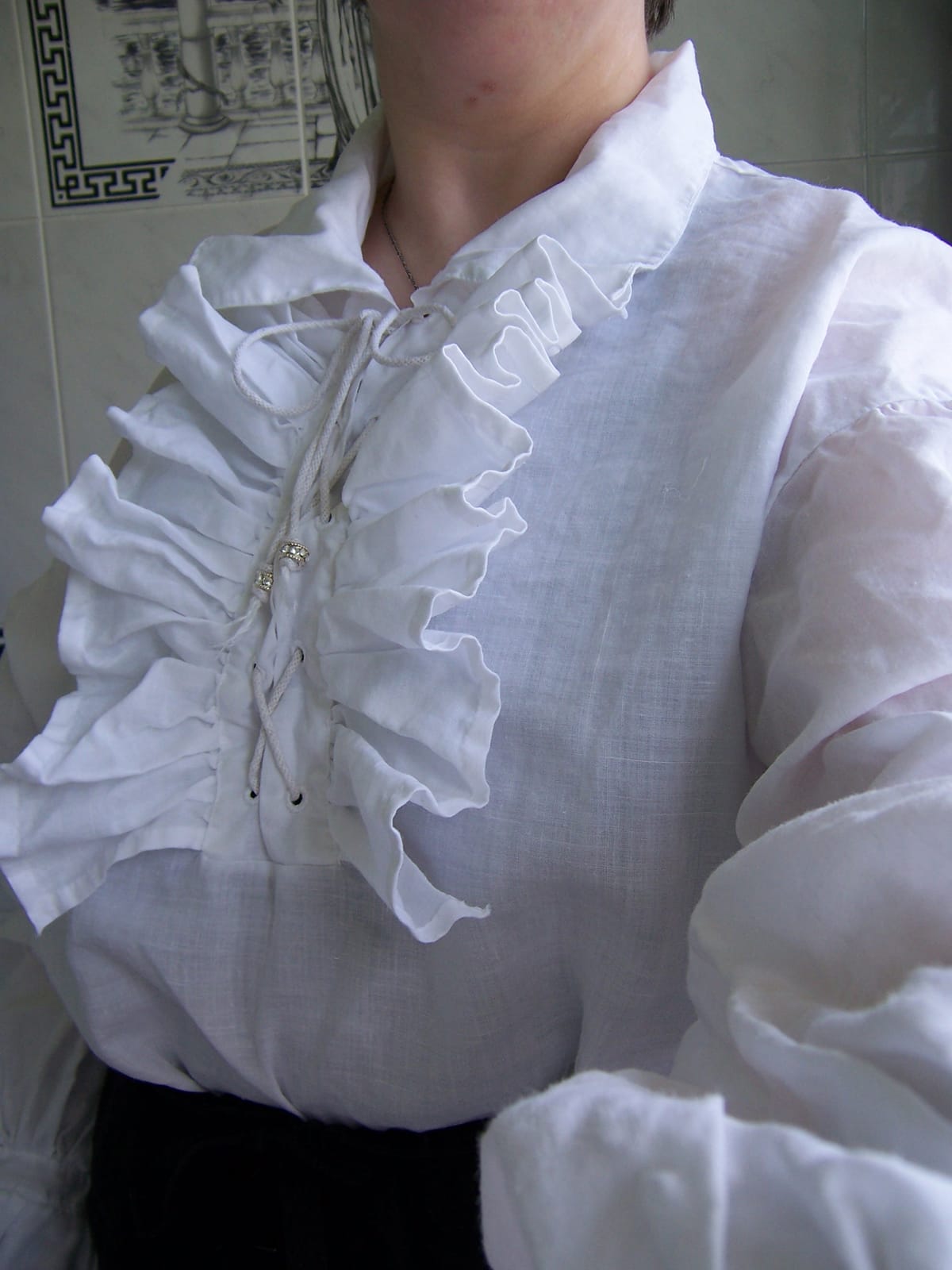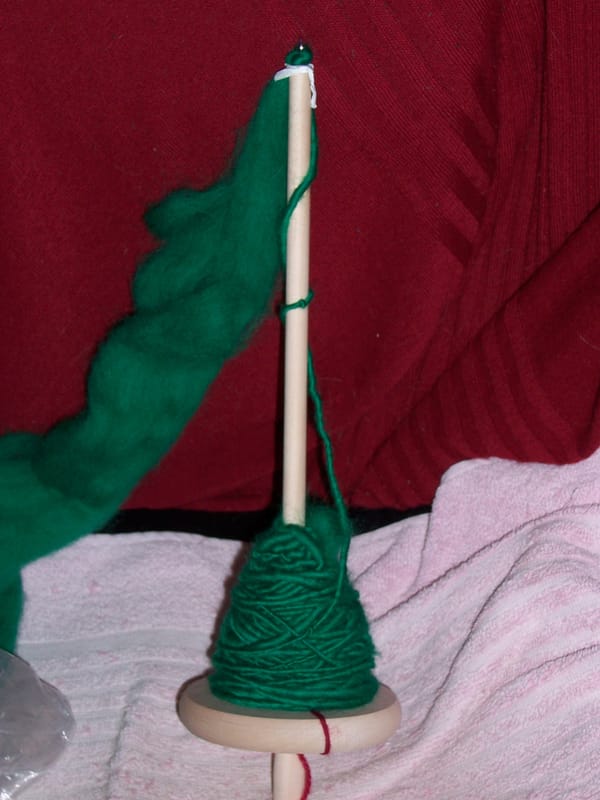Getting mediaeval

Mr Wooster's Victorian shirt wasn't the only linen shirt I made. There was also this one.
I'm not exactly sure what I made it for, except possibly just the sheer fun of it (oh, and hot weather; I dislike hot weather with a passion, but I need to stay well covered up otherwise I burn, and white linen is a pretty good way of addressing that). I also can't find the pattern any more, so I think it must have been discontinued, which is, after all, pretty common; however, you can still get plenty of poet/pirate/late-mediaevalish sort of shirt patterns, such as this one, which is quite similar to the one I used. In fact, I may just treat myself to that pattern for the summer. I won't be using pure linen next time, because although it is wonderfully cool it does also crease like the dickens, and my ability to iron is somewhat circumscribed these days; however, a linen/viscose blend would work well, if I can manage to get one that doesn't have a wild print, or failing that maybe a pure viscose. Tencel lyocell is another possible contender, but that is expensive and I haven't yet worked with it... though I shall be doing so quite soon. I am not usually much of a prints person, but I saw some Tencel lyocell fabric in a really lovely alstroemeria print on a black background at 20% off, and so I shall at some point in the not-too-distant future be making a maxi skirt and matching blouse. I'll see how that works, and if I like it enough to justify the price, then I could well end up going for that for the next lace-up shirt I make.
Anyway, I seem to recall that the pattern recommended using metal eyelets; and I thought, that's no good. When people were originally wearing shirts like this, they didn't have metal eyelets. I have no problem with metal eyelets in principle (as long as they don't actually come into contact with my skin; I'm one of those people who is not only allergic to nickel, which is very common, but it's pretty much the case that if it's a metal and it's not copper, silver, or gold, I'm going to get a reaction), but if I'm going to go all historical I want to do it as properly as I can manage. So I punched holes with a tailor's awl and finished them with buttonhole stitch. The eyelets are, in fact, very much like tiny buttonholes in that I did a little circle of stitching round the area before punching each hole, just as I'd do for a regular buttonhole; it always makes sense to do this if you have more than one thickness, even if the fabric isn't inclined to fray, because it keeps the layers together, and incidentally it also reinforces the edge of the buttonhole or eyelet.
The cord is kumihimo. I can't remember exactly what sort of thread I used for it, but looking at the picture, both the gauge of the cord and the obvious softness of the end fibres make me think it was probably fine crochet cotton, which would make sense. I also can't remember where I got those lovely bead finials, but they were absolutely perfect; just tie a knot on each side of the bead and it stays firmly in place and provides not only a decorative end to the cord, but also a little bit of weight so that the cord is less inclined to flap about or twist. I strongly suspect I spotted them in John Lewis' haberdashery department, which used to be excellent, but is not these days (and that is the same all over; their haberdashery department in Sheffield used to take up half the ground floor, but it was shrinking even while I was living there, while the one in the nearest town to where I now live was quite good when I first moved to the area but has disappointed me slightly more every time I have subsequently been able to visit it).
The ruffles do look quite impressive but they weren't actually that hard; it was just a question of adjusting the gathers evenly. I don't know what it told me to do in the pattern, but I would pretty much swear in court I used at least two gathering threads, because it makes the job so much easier; that little bit of extra friction means that the gathers are much more amenable to staying put when you need them to do so. The hard bit came later, of course. That was ironing them. They were truly horrible to iron! You can't see the cuffs in this photo, but they were also ruffled, and although the cuff ruffles were much smaller they were easier to iron because they just stuck out from the end of the cuffs, rather than lying above a flat layer of fabric.
Apart from the ironing, it was a great shirt. I wore it a lot. It washed with no problems, it was surprisingly good at shrugging off stains considering it was white, and it kept me cool in the summer. (I should possibly mention here that my ugly little house in Sheffield had a flat black asphalt roof which acted as a heat trap, so the upstairs used to get unbearable in a heatwave. If it got too bad I'd have to sleep in the living room, and I'd usually wake up covered in cats.) I'm not sure about linen/viscose blends from a care point of view, but viscose does need treating with a little more care, and Tencel lyocell... honestly, I used to have silk that was more robust. I looked up how to care for it the other day, and it turns out you have to wash it at a maximum of 30 degrees, preferably by hand, but you can use the wool/delicate wash if you need to; don't use fabric conditioners (that's fine, as I don't anyway - I don't like the smell); don't put any garments with metal fasteners in the same wash, in case they catch; don't wring; preferably air dry, but you might possibly be able to tumble dry on the lowest setting... OK. I had better really like this fabric when it arrives. You'll find out, whichever way it goes, because there will be a full post on this at some point.
In the meantime, I'm still getting on with my 29-piece calico-backed sewing project, and I cannot wait to get that finished so I can a) show you and b) post it off to the lucky recipient, who happens to be Porthos. It's his Christmas present. All I'll say for now is it's a good job I'm so fond of him!




